Off Grid Solar 12V 220V Pure Sine Wave Inverter 500W to 2400W with MPPT Charge Controller PF 0.8
- Loading Port:
- Qingdao
- Payment Terms:
- TT or LC
- Min Order Qty:
- 50 unit
- Supply Capability:
- 30000 unit/month
OKorder Service Pledge
OKorder Financial Service
You Might Also Like
1. Structure of Off Grid Solar 12v 220v Pure Sine Wave Inverter 500W to 2400W with MPPT Charge Controller PF 0.8
A solar inverter, or PV inverter, or Solar converter, converts the variable direct current (DC) output of a photovoltaic (PV) solar panel into a utility frequency alternating current (AC) that can be fed into a commercial electrical grid or used by a local, off-grid electrical network.
It is a critical BOS–component in a photovoltaic system, allowing the use of ordinary AC-powered equipment.
Solar inverters have special functions adapted for use with photovoltaic arrays, including maximum power point tracking and anti-islanding protection.
2. Main Features of the Off Grid Solar 12v 220v Pure Sine Wave Inverter 500W to 2400W with MPPT Charge Controller PF 0.8
﹒Multi-Setting
﹒High Reliability: Double CPU Digital Control
﹒Isolated and Pure Sine Wave Technique
﹒LCD+LED Display Mode
﹒Wide Input Range
﹒High-Speed Synchronous Conversion
﹒Friendly Alarm System
﹒Online Protection Function
﹒Intelligent No-Load Auto Shutdown Technology
3. Off Grid Solar 12v 220v Pure Sine Wave Inverter 500W to 2400W with MPPT Charge Controller PF 0.8 Images
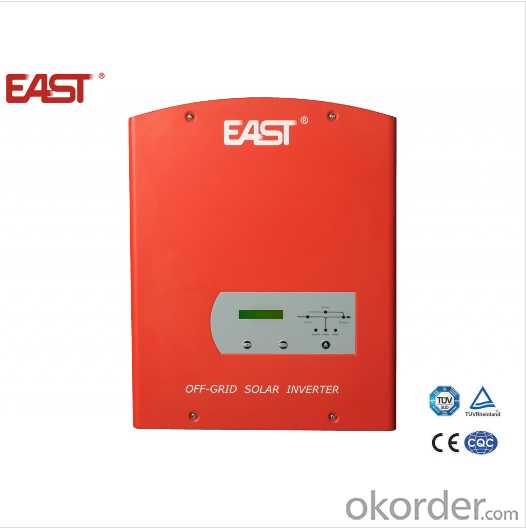
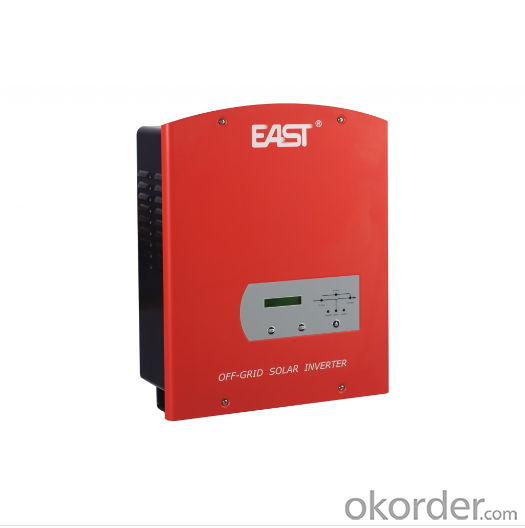
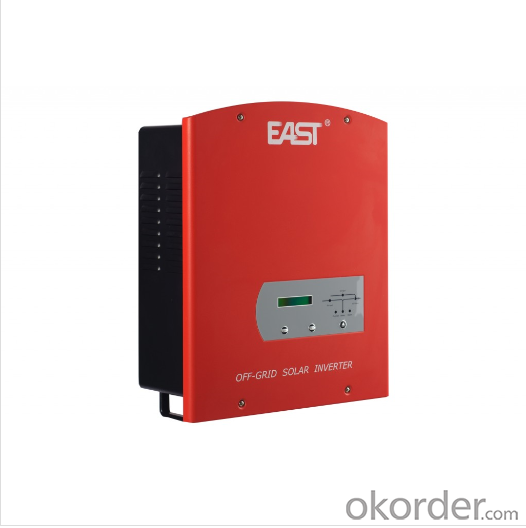

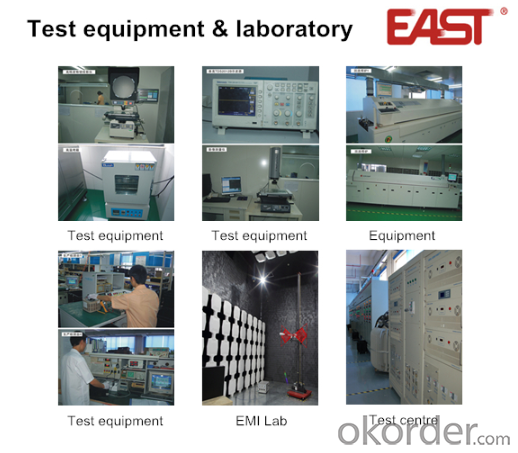
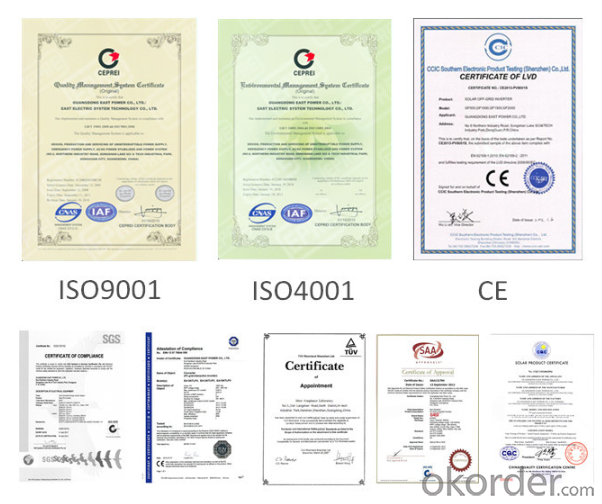
4. Off Grid Solar 12v 220v Pure Sine Wave Inverter 500W to 2400W with MPPT Charge Controller PF 0.8 Specification
Model | GF500 | GF1000 | GF1500 | GF2000 | GF2400 | ||
Capacity | 500VA | 1000VA | 1500VA | 2000VA | 2400VA | ||
Power | 500W | 1000W | 1500W | 2000W | 2400W | ||
Battery voltage/ range | 24Vdc/21-30Vdc | 48Vdc/42-60Vdc | |||||
Working mode | PV(Photovoltaic priority) / AC(AC priority) Optional | ||||||
PV | MPPT voltage range | 24Vdc~ 45Vdc | 48 Vdc ~ 90Vdc | ||||
Max. charge current | 10A/20A/30A/40A (option offered) | 10A/20A/30A/60A | |||||
Conversion efficiency | ≥ 98 % | ||||||
Display | Panel indicator light | LCD + LED display | |||||
Mains status(Optional) | Input voltage range | 100V/110V/120V/220V/230V/240V±25%(Customized) | |||||
Input Frequency range | 45-65 Hz(Automatically transfer to inverter power when overfrequency) | ||||||
Output voltage range | 100V/110V/120V/220V/230V/240V± 10% | ||||||
Input PF.(AC/DC) | 98% | ||||||
charge current | 15Amax(PV Charging current≤Rated 25% battery≤90%) | ||||||
Efficiency | Mains mode≥ 96% | ||||||
Mains overload | 110% 60s transfer to bypass power; 120% transfer to bypass power supply after 30s;automatically recover when decrease load | ||||||
Short circuit | Input fuse | ||||||
Inverter output | Inverter output voltage | 100V/110V/120V/220V/230V/240V± 5% | |||||
Output frequency | 50 Hz / 60Hz ± 1% frequency adaptive | ||||||
Output power factor | 0.8 | ||||||
Wave form distortion | Linear load≤ 5% | ||||||
PV-AC transfer time | 5Ms typical value Max.8 Ms | ||||||
Max.Efficiency | 84.50% | ||||||
Inverter overload | 110% shutdown at 60s,120% shutdown at 5s | ||||||
No-load off | Load< 5% The system automatically shut down at 1MIN, transfer to bypass power supply | ||||||
(Optional) | |||||||
Short circuit | Systems automatically shut down | ||||||
Alarm | Mains abnormal | 1/4S; automatic sound elimination after 40s | |||||
Low battery | 1 / 0.2S | ||||||
Overload | 1 / 1S | ||||||
Communication interface (Optional) | RS232 / USB / SNMP(Setup available for regular start/shutoff) | ||||||
Others | Output sockets | Universal sockets 3PCS / customized | |||||
Surge protection | Optional | ||||||
EMC | EN62040-2:2006;EA61000-3-2:2006; EA61000-3-3:2008 | ||||||
IP class | IP20 | ||||||
Ambient temperature | 0°C ~ 40°C | ||||||
Ambient humidity | 10% ~ 90%(Non Condensed) | ||||||
Noise | ≤ 50dB | ||||||
Dimension | Hanging | 380*195*478 | |||||
D*W*H(mm) | Tower | 420×145×215 | 475×200×337 | ||||
Packing dimension(mm) | Hanging | 455*255*522 | |||||
Tower | 515×236×316 | 592×320×462 | |||||
Weight(kg) | 11 | 13 | 18.8 | 23.7 | 27 | ||
Packing weight(kg) | 11.8 | 13.8 | 20 | 25 | 28.2 | ||
5. FAQ of Off Grid Solar 12v 220v Pure Sine Wave Inverter 500W to 2400W with MPPT Charge Controller PF 0.8
Q1. What is the difference between inverter and solar inverter?
A1. Inverter only has AC inpput, but solar inverter both connect to AC input and solar panel, it saves more power.
Q2. What is the difference between MPPT&PWM?
A2. MPPT has higher efficiency, it can track the max power point and won't waste energy.
Q3. What is the waranty of product?
A3. 12 months.
- Q:What is the role of a solar inverter in preventing electrical faults?
- The role of a solar inverter in preventing electrical faults is to convert the direct current (DC) generated by solar panels into alternating current (AC) that can be used by appliances and the electrical grid. By regulating and controlling the flow of electricity, a solar inverter ensures that the voltage and frequency levels are within acceptable limits, preventing overloading, overheating, and electrical faults that could potentially damage the system or cause safety hazards.
- Q:How does a solar inverter prevent reverse current flow?
- A solar inverter prevents reverse current flow by using a specialized circuitry called anti-islanding protection. This circuitry constantly monitors the grid and disconnects the solar system from it when it detects a drop in voltage or a power outage. This ensures that any excess energy generated by the solar panels does not flow back into the grid, preventing potential damage to the system and protecting utility workers during maintenance or repairs.
- Q:What are the main components of a solar inverter system?
- The main components of a solar inverter system include the solar panels, the inverter itself, a charge controller, batteries (if it is an off-grid system), and the electrical wiring and connections.
- Q:What is the role of a display or user interface in a solar inverter?
- The role of a display or user interface in a solar inverter is to provide users with real-time information about the performance, status, and operational parameters of the inverter system. It allows users to monitor the energy production, voltage levels, current flow, and any potential faults or errors. Additionally, the user interface enables users to configure and control various settings of the solar inverter, such as output power limits, grid synchronization, and system diagnostics.
- Q:How does the input voltage rating affect the performance of a solar inverter?
- The input voltage rating of a solar inverter directly affects its performance. The inverter is designed to convert the DC power generated by the solar panels into AC power that can be used in homes or businesses. If the input voltage exceeds the rating of the inverter, it can cause damage to the electronics and reduce its efficiency. On the other hand, if the input voltage is too low, the inverter might not be able to operate at its full capacity. Therefore, it is crucial to choose an inverter with an input voltage rating that matches the specifications of the solar panels to ensure optimal performance and longevity.
- Q:How does shading affect the performance of a solar inverter?
- Shading can significantly impact the performance of a solar inverter as it reduces the amount of sunlight reaching the solar panels. This leads to lower energy production and decreased efficiency of the inverter. Shading can cause imbalances in the overall system, resulting in reduced power output and potential overheating of the inverter. Additionally, shading can lead to the activation of safety mechanisms within the inverter, such as Maximum Power Point Tracking (MPPT) algorithms, which further decrease its performance. Therefore, avoiding shading or implementing shading mitigation techniques is crucial for maximizing the performance of a solar inverter.
- Q:Are there any safety risks associated with solar inverters?
- Yes, there can be safety risks associated with solar inverters. While solar inverters are generally considered safe, there are a few potential hazards to be aware of. These include electrical shock, fire hazards, and the release of toxic gases. It is important to ensure proper installation, regular maintenance, and adherence to safety guidelines to mitigate these risks.
- Q:How do you choose the right output voltage for a solar inverter?
- When choosing the right output voltage for a solar inverter, it is crucial to consider the specific requirements of the electrical appliances or systems that will be powered by the inverter. The output voltage must match the voltage requirements of the devices to ensure compatibility and efficient operation. Additionally, the local electrical grid standards and regulations should be taken into account, as certain regions may have specific voltage requirements. It is advisable to consult with a professional or an electrician who can assess the specific needs and provide guidance in selecting the appropriate output voltage for the solar inverter.
- Q:What is the role of MPPT (Maximum Power Point Tracking) in a solar inverter?
- The role of MPPT (Maximum Power Point Tracking) in a solar inverter is to optimize the efficiency and output of the solar panel system. MPPT technology enables the inverter to constantly track and adjust the operating point of the panels, ensuring that they are operating at their maximum power point, where the highest power output is achieved. This allows the system to capture the maximum amount of energy from the sun, maximizing the overall efficiency and performance of the solar inverter.
- Q:Are there any maintenance requirements for a solar inverter?
- Yes, solar inverters do have maintenance requirements. Regular cleaning of the solar inverter and its components is necessary to remove dust and debris. Additionally, checking for loose connections, inspecting for any physical damage, and ensuring proper ventilation are important maintenance tasks. It is also recommended to monitor the inverter's performance regularly and promptly address any issues or errors that may arise.
1. Manufacturer Overview |
|
|---|---|
| Location | |
| Year Established | |
| Annual Output Value | |
| Main Markets | |
| Company Certifications | |
2. Manufacturer Certificates |
|
|---|---|
| a) Certification Name | |
| Range | |
| Reference | |
| Validity Period | |
3. Manufacturer Capability |
|
|---|---|
| a)Trade Capacity | |
| Nearest Port | |
| Export Percentage | |
| No.of Employees in Trade Department | |
| Language Spoken: | |
| b)Factory Information | |
| Factory Size: | |
| No. of Production Lines | |
| Contract Manufacturing | |
| Product Price Range | |
Send your message to us
Off Grid Solar 12V 220V Pure Sine Wave Inverter 500W to 2400W with MPPT Charge Controller PF 0.8
- Loading Port:
- Qingdao
- Payment Terms:
- TT or LC
- Min Order Qty:
- 50 unit
- Supply Capability:
- 30000 unit/month
OKorder Service Pledge
OKorder Financial Service
Similar products
New products
Hot products
Hot Searches
Related keywords






























